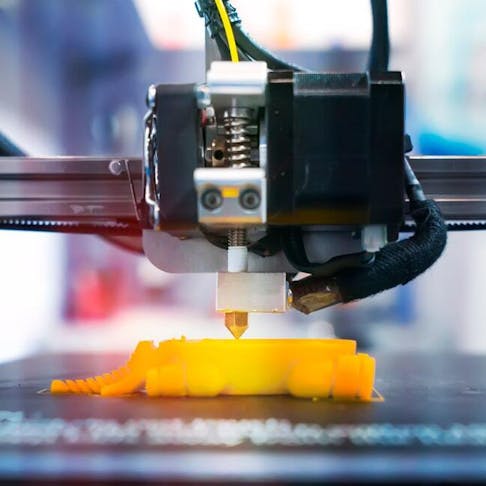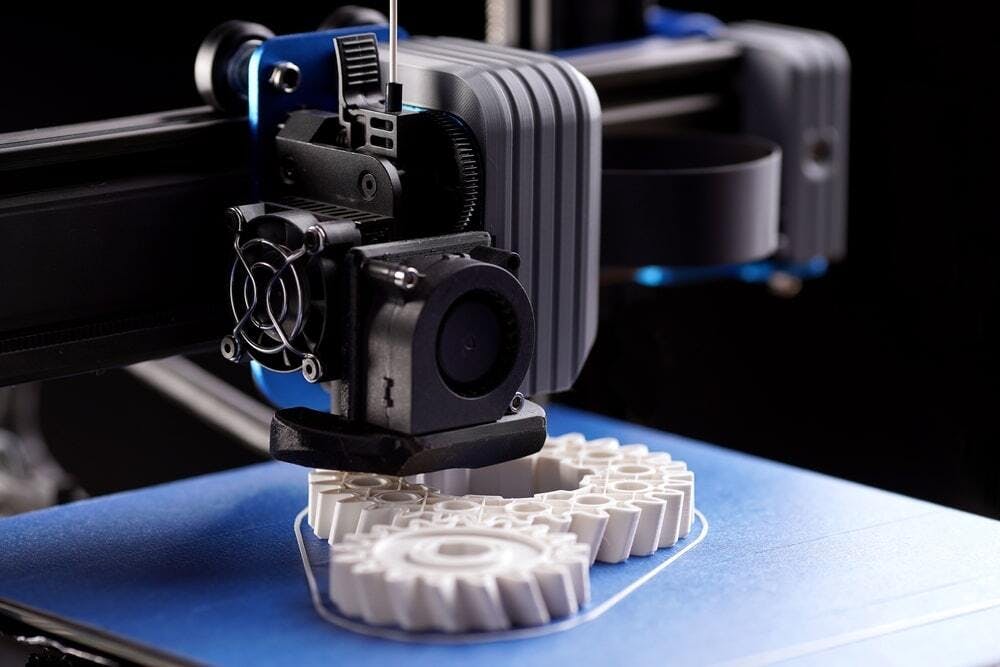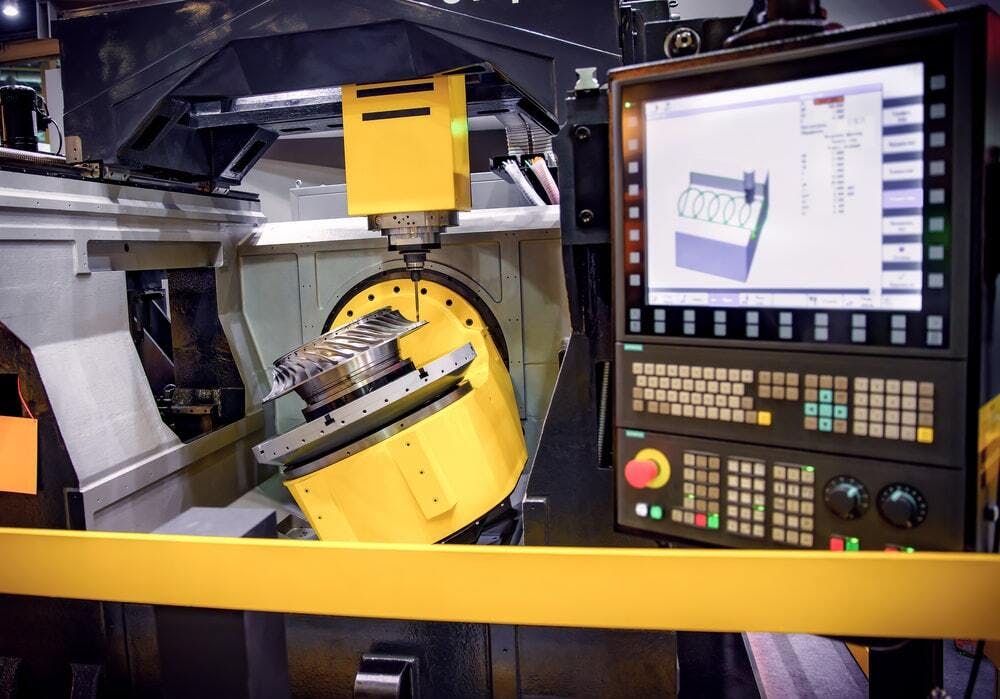
3D Printing vs. CNC Machining: Differences and Comparison
Learn about the comparison of the 3D printing and CNC machining manufacturing processes.

3D printing, or additive manufacturing, builds 3D files as a series of co-bonded slices. These are constructed like a stack of pictures of finite thickness. The term 3D printing covers a range of methods and an even wider range of materials, accuracies, and costs. CNC (Computer Numerical Control) machining achieves similar results through subtractive manufacturing. It cuts the net shape of a part out of a block of material using rotating tools or rotating the workpiece or both. CNC machining has design limitations and virtually no materials limitations. If the material is rigid and can be cut, then any part can be made in any material. Some flexible materials, rubbers, for example, can even be processed while cryogenically stabilized. Geometric restrictions apply, and enclosed hollows may require the assembly of two or more parts.
While the processes differ in almost every respect, they are direct competitors for the provision of solid parts. Both differ in very fundamental regards as CNC machining is subtractive, while 3D printing is additive. This article will dive deeper into comparing 3D printing vs. CNC machining, their advantages, disadvantages, and alternatives.
3D Printing Definition and Comparison to CNC Machining
3D printing is a family of processes that have a common thread of methodology. Virtual models of 3D parts are software-rendered as slices. The thickness is determined to suit a particular machine or setting, and each layer is printed sequentially. The stacking of these slices and their co-bonding, both internally and to the other slices allows the construction of a part from finite 2D steps. Some systems use a variety of materials including: extruded polymer filaments, light-sensitive resins, laser-melted powders, filament feedstock, waxes, and biological materials to print slices. To achieve this, several tools must be integrated, including: a CAD package to define the part design and save an STL file, a slicer software package to turn the 3D file into a sequence of 2D machine instructions, and a 3D printer setup.
The earliest commercially viable 3D printing systems began to come to market in the late 1980s. The technologies have broadened both in method and materials at an accelerating pace since then. Compared to CNC machining, 3D printing offers improved cosmetics and more effective use of materials. It also requires no direct handwork in executing complex parts. Figure 1 below is an example of an FDM 3D printer:
An FDM 3D printer.
Image Credit: Shutterstock.com/R_Boe
What Are the Advantages of 3D Printing Compared to CNC Machining?
The advantages of 3D printing compared to CNC machining are:
- 3D printing delivers net shape parts quickly, whereas CNC machining requires individual setup and (generally) manual programming plus supervision.
- 3D printing is generally a lower-cost method than other ways of making complex net shapes. It requires minimal setup and operational intervention. It’s common for CNC components to be 10x the price of 3D printed parts.
- 3D printers that are office friendly and require only modest skills in setup and maintenance are increasingly common. They are also increasingly capable of satisfying the majority of needs. CNC remains a heavy-engineering and highly skilled process requiring constantly refreshed skills in the operators.
What Are the Disadvantages of 3D Printing Compared to CNC Machining?
The disadvantages of 3D printing compared to CNC machining are:
- Various 3D printing processes offer varied strength compared with the “native” properties of the materials. For example, as low as 10 % of material UTS for FFF in ABS is reported, and as much as 100% for SLS of nylon. CNC machining produces parts in undisrupted native materials, so the strength is generally high.
- 3D printing can achieve good dimensional accuracy, but where high precision is required it can be challenging. CNC machining is highly precise and allows improved accuracy by slower processing.
- 3D printing is generally affected by process mechanics concerning surface finish. Z-resolution in particular brings stepped surfaces and visual disruptions. CNC surface finish is as machined; it can be extremely uniform and highly precise if cutter paths are programmed for a smooth finish.
CNC Machining Definition and Comparison to 3D Printing
CNC machining is a computerized manufacturing process that uses pre-programmed software and codes to control the movement of machine tools. It is a technology that uses a range of complex machineries such as lathes, mills, and grinders to accurately and precisely cut, create, and shape different parts. The first CNC machine was first developed in 1949 by James Parson. His research focused on producing helicopter blades and aircraft blades. In 1958, Richard Kegg together with MIT first created the CNC milling machine.
CNC machining requires a complex setup and expensive outcomes. However, if the parts require long-term wear properties, strength, smooth surface, and high precision, it's preferable compared to 3D printing. Figure 2 is an example of a CNC milling machine:
To learn more, see our guide on What is CNC Machining.
CNC milling machine.
Image Credit: Shutterstock.com/Andrey Armyagov
What Are the Advantages of CNC Machining Compared to 3D Printing?
The advantages of CNC machining compared to 3D printing are:
- CNC machining uses engineering materials and delivers the full properties of the materials, undisrupted by the process. 3D printing, on the other hand, can sometimes achieve this, but generally uses weaker material approximations.
- CNC parts are more precise, as machine tolerances can be held closer than 3D print tolerances.
What Are the Disadvantages of CNC Machining Compared to 3D Printing?
The disadvantages of CNC machining compared to 3D printing are:
- CNC machining often requires mounting tools to be made. This complicates the job considerably, whereas 3D printing makes free floating parts built on a table or scaffold.
- CNC machining cuts away not required material, making ‘waste’ in the cutting. 3D printing is characterized as a ‘low waste’ option.
| Attribute | 3D Printing | CNC Machining |
|---|---|---|
Attribute Unlimited material availability | 3D Printing No | CNC Machining Yes |
Attribute Part design | 3D Printing Unrestricted by process constraints | CNC Machining Limited by undercut and internal access, tool path and tool type, axis-defined minimum radii, and the need for repositioning mid-task |
Attribute Precision | 3D Printing Processes vary from 0.016 resolution to 1 mm+. Typically around 0.2 mm | CNC Machining 0.005 mm precision, where slow feeds, new cutters, and shallow cuts are employed |
Attribute Operator skill | 3D Printing Generally relatively low | CNC Machining Very high |
Attribute Speed of build | 3D Printing Low setup time, but build time generally takes hours | CNC Machining Can be very high setup and programming time; cutting stages are very fast |
Attribute Surface finish | 3D Printing Grained, rough, and stepped; features are often blurred | CNC Machining Can deliver very high surface quality by using longer cut times |
Attribute Strength | 3D Printing Often 10–20 % of native material | CNC Machining Generally 100 % of native material |
Attribute Cost | 3D Printing Assume a cost of $X | CNC Machining Generally $5X to $10X |
3D printing offers advantages in terms of cost and time to build parts. CNC machining, on the other hand, can deliver a close correlation to mass production characteristics whenever the precision of the part is a critical factor.
3D Printing vs. CNC Machining: Lead Cost Comparison
CNC machining will carry all of the programming and setup costs and it will be expensive in comparison to 3D printing – often five to ten times the price. However, whenever a series of prototypes with small adjustments are required, the modified CNC-cut parts will carry a much lower setup cost, whereas a second 3D printed part will cost the same as the first.
3D Printing vs. CNC Machining: Speed Comparison
Preparation for the printing of a 3D component requires little time to set up before a print can commence. Although printing is slow by some measures, most prints will likely complete within a few hours and be ready to use. CNC machining, on the other hand, requires skilled preparation of programming for cutter selection and cutter path. It often requires custom or modified jigs to retain the part during processing (including possible repositioning of the part). This can consume considerable time before the first cut. Cutting, however, is generally fast, and complex parts can generally be completed in an hour or less of actual machining. Total time for preparation and machining can run into a day or more, depending on complexity.
3D Printing vs. CNC Machining: Volume Comparison
When the extensive setup effort can be shared over multiple parts, CNC machining can produce more cost-effective parts compared to 3D printing. 3D printing has fewer volume advantages, as each part takes the same material and machine costs, irrespective of volume.
3D Printing vs. CNC Machining: Materials Comparison
In material selection (and successful delivery of material properties), CNC offers better options. Essentially the material choice is open to all engineering materials, up to and including spark-erosion CNC machining of pre-hardened tool steels. CNC-machined parts deliver the native properties of the billet material, largely undisturbed by processing characteristics.
3D printed parts are restricted to those supported by particular processes. The construction methods of the particular 3D print technology impose severe restrictions on the delivery of properties. Prints are often weakened by anisotropic “grain” in the construction method, porosity, poor layer bonding, and the substitution of printable but non-engineering materials.
What Are the Mutual Alternatives to the 3D Printing and CNC Machining?
A mutual alternative to 3D printing and CNC machining is:
- Injection Molding: Injection molding can be considered an alternative to 3D printing and CNC machining of parts, in that it is a single-operation process to produce a net shape part that is identical to the 3D file. In reality, the tool-making process rules out the use of injection molded parts as a substitute for most 3D print applications – unless the required production volume is sufficiently high.
What Are the Similarities Between 3D Printing and CNC Machining?
3D printing and CNC machining are similar in that both processes can produce functional products. In terms of processes, however, 3D printing and CNC machining do not have anything in common.
What Are the Other Comparisons for 3D Printing Besides CNC Machining?
A possible alternative to 3D printing is:
- 3D Printing vs. Laser Cutting: Like SLS, DMLS, and SLM 3D printers, laser cutting uses high-powered lasers to produce parts. Both technologies are also used in a wide variety of industries and make use of a wide range of metals. For more information, see our guide on 3D Printing vs. Laser Cutting.
What Are the Other Comparisons for CNC Machining Besides 3D Printing?
An alternative to CNC machining is:
- CNC Machining vs. Die Casting: Like CNC machining, die casting is another method of producing a complex net shape in metal. However, there are considerable tooling costs in manufacturing a die-cast metal part. Nevertheless, as volumes rise, the case for die casting improves.
Summary
This article presented a comparison of 3D printing to CNC machining, explained what they are, and discussed their different attributes. To learn more about 3D printing and CNC machining, contact a Xometry representative.
Xometry provides a wide range of manufacturing capabilities, including 3D printing and other value-added services for all of your prototyping and production needs. Visit our website to learn more or to request a free, no-obligation quote.
Disclaimer
The content appearing on this webpage is for informational purposes only. Xometry makes no representation or warranty of any kind, be it expressed or implied, as to the accuracy, completeness, or validity of the information. Any performance parameters, geometric tolerances, specific design features, quality and types of materials, or processes should not be inferred to represent what will be delivered by third-party suppliers or manufacturers through Xometry’s network. Buyers seeking quotes for parts are responsible for defining the specific requirements for those parts. Please refer to our terms and conditions for more information.


